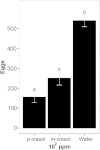Gravid females of the mosquito Aedes aegypti avoid oviposition on m-cresol in the presence of the deterrent isomer p-cresol
- PMID: 25008201
- PMCID: PMC4101705
- DOI: 10.1186/1756-3305-7-315
Gravid females of the mosquito Aedes aegypti avoid oviposition on m-cresol in the presence of the deterrent isomer p-cresol
Abstract
Background: p-cresol (4-methylphenol) and its isomer m-cresol (3-methylphenol) have been shown to activate the same sensilla in Aedes aegypti (Linnaeus) mosquitoes. Whereas p-cresol has been suggested to play a role in oviposition site choice, the behavioral significance of m-cresol is unknown.
Methods: Here, we assayed the oviposition behavior of Aedes aegypti towards p-cresol and m-cresol using cage assay. Specifically we tested different concentrations of p-cresol (10-12-103 ppm) and m-cresol (10-1-103 ppm), the 1:1 mixture of the two compounds at 102 ppm, and the two individual compounds at 102 ppm together in the same cage.
Results: We show that (1) p-cresol is a stimulant at a low concentration and deterrent over a broad range of higher concentrations (10-8-103 ppm), while m-cresol was behaviorally ineffective, except for a deterrent effect at the highest concentration (103 ppm) (2) in concentration choice tests (different concentrations tested against each other), both compounds were deterrent only at the highest concentration (3) a 1:1 mixture of both compounds exhibited a deterrent effect on oviposition (4) when presented in separate cups but together in the same cage, p-cresol and m-cresol (102 ppm) both received significantly less eggs than water alone.
Conclusions: Our results suggest that p-cresol is a strong oviposition deterrent with a stimulant effect at only a very low concentration, while m-cresol is not a deterrent per se. However, in the presence of p-cresol in the vicinity, m-cresol acts as a deterrent. This finding adds a new twist to the possible interactions of different odors in oviposition site choice: not only the source itself, but nearby odors also influence a mosquito's choice.
Figures








References
-
- Navarro-Silva MA, Marques FA, Duque LJ. Review of semiochemicals that mediate the oviposition of mosquitoes: a possible sustainable tool for the control and monitoring of Culicidae. Rev Bras Entomol. 2009;53:1–6.
Publication types
MeSH terms
Substances
LinkOut - more resources
Full Text Sources
Other Literature Sources

